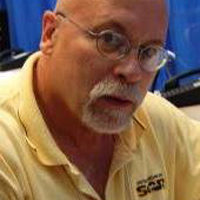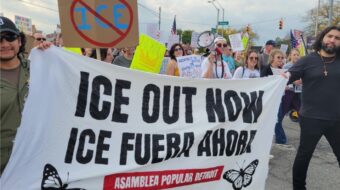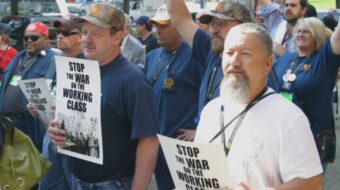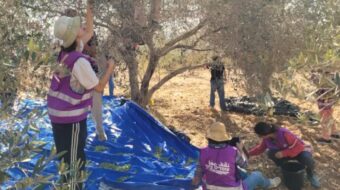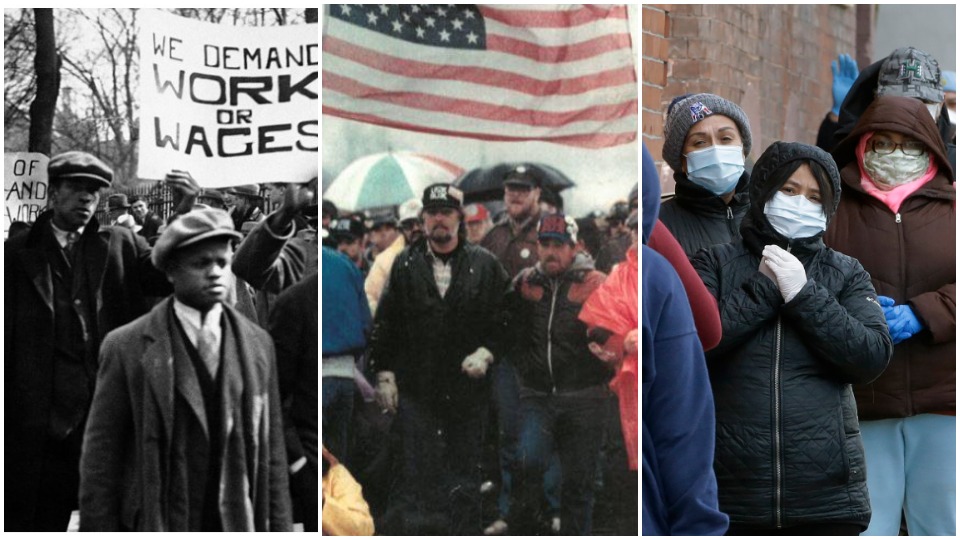
Editor’s Note: There were periods in U.S. history when workers responded to high jobless rates by forming “unemployed councils.” In this article, a labor activist who was involved in the 1980s in setting up such a council describes his experiences. Some are asking whether similar movements might help in these times of high unemployment. We hope you find this look back into the past by Bruce Bostick, a lifetime labor activist, both informative and helpful.
Unemployed Councils cropped up across the country in the 1930s during the Great Depression and again in the 1980s after the mass layoffs in the steel industry. I was a part of the effort to start up such a council in Lorain, Ohio.
Our Lorain Communist Party club played the key role in establishing and running a storefront coalition grouping, the Unemployed Crisis Center, that won benefits for workers and positively affected how organized labor and public officials treated the unemployed. We were able to concretely help thousands of unemployed workers and, as a side benefit, we recruited new folks to the CPUSA.
We also suffered some major setbacks. Hopefully, I’m able to pass on here some lessons we learned.
We had re-established our CP club in Lorain as a steel club, in 1970, with some younger workers on the one hand and George Edwards, the only veteran member left from an earlier period of glory.

Our main work had been in the steel union, USWA Local 1104, with 8,000 members. We’d helped form a Rank & File Committee that pushed to involve workers in the union, pushed for solidarity and democracy, and to bring younger workers, minority workers, and women into leadership. We had elected a few to leadership and made some gains, including the publishing of a regular newsletter.
When a major cutback, with big layoffs, hit our local, it caused cutbacks throughout the surrounding community of local shops, businesses, and public services. A major crisis developed, with misery and suffering affecting most of the people we knew. We felt we had to react, to do something to help out.
We felt it was very important that the laid-off workers be treated with dignity, that the union represent them well, fight for them to return to work by seniority and not allow the company to use favoritism, racism, or skill sets to avoid fighting for their return.
Also, the company was pushing overtime on the workers who were not laid off, and we pushed to fight to return everyone to work. Younger African-American and Latino workers were a huge percentage of those laid off, having been the most recently hired.
We pushed the union to stand up and fight by setting up an official Unemployed Workers Committee.
A concern we had was that workers would turn against our union if they saw them not fighting hard. Unfortunately, the majority of leadership at that time was still conservative, influenced by red-baiting and some levels of racism. When the issue was raised, the grievance committee turned it down, seeing it as adding more work, plus it saw no reason to do that work anyway.
George Edwards tugged on my chain at that time, as I was angry, wanting to blast other union leaders for failing to set up that committee. As always, he pushed to help us understand why it was so important to continue to fight for unity, to insist that the unemployed (as well as the left) were part of our labor movement. As at other critical moments, he pointed out that unemployed workers were part of our unions and that we could not let them be isolated and pushed out. If that were to happen, it would weaken us all.
I had a good friend, the craneman I worked with in the mill, Willie Gardner. He was a wonderful guy who’d known Martin Luther King, Jr., and had been involved in civil rights struggles in Alabama before coming to Lorain. He was also a pastor, heading Mt. Zion Church in Lorain. While we had “joked” about joining each other’s groups, the Communist Party and the church, Rev. Gardner also very seriously asked for the party’s help in setting up a food program to help unemployed workers and their families.
Discussing this project, the party club decided that it was an important one because the people needed help and the church might just do some of us some good!
Working at Mt. Zion, we set up a “Crisis Center” that was able to begin filling in some gaps in needs that laid-off workers had. We were able to put together a solid multi-racial leadership. We got food to some workers and also became experts in all the possible benefits workers might be eligible for.
Being a group that knew where to send workers for existing aid was helpful because people don’t know all the programs, where to go, or how to access them.
We also attended the official Central Labor Council meetings, making sure the African-American leaders of what we now called the Unemployed Crisis Center (UCC) felt at home, spoke at the meetings, and were part of CLC activities.
Some of those leaders who were also USWA members ran for union office with our Rank & File Committee, and a couple were appointed to union positions. This did result in more African-American workers attending union meetings and becoming active with the union.
During this period, we got some minor help, some tacit support from the union and the CLC. The UCC began to be recognized as an actual part of the labor movement. Besides helping involve more minority workers in the union, the UCC example pushed the local to shift then, semi-officially setting up special representation for laid-off workers.
Weekly mass meetings were organized for them, and the union got official Lay-Off/Return lists, showing seniority dates for laid-off workers and the role of those working. We got the union to push a mass grievance, signed by hundreds, citing a contract section that “discouraged use of overtime to avoid recall of laid-off workers.”
Also, when an African-American church in nearby Elyria was vandalized, UCC was able to get a multiracial group of steelworkers/friends to help clean it up. When we found some racist literature in a mill shop, the union wrote up the union position for unity against racism.
Relationships were developed between unions and rising authentic community leaders, especially Curtis Nelson and David Flores. Flores was a leader that had been a steelworker, taking advantage of the Consent Decree to gain a carpenter’s card. He pushed hard for upgrading less-developed, mainly Hispanic areas. Dave also became president of the non-teaching employee’s union and a leader of the labor federation. The Campedo area was heavily Puerto Rican and was without sidewalks or sewer development. We worked to support the drive, led by Flores, to upgrade this area. Flores, along with then Rep. Sherrod Brown, became long-range future leaders fighting for labor and minority communities.
The UCC became a well-known center of activity in town. Laid-off workers made it the first stop after the Unemployment Office. We were the first to find out when the government cheese was coming in.
Now-Sen. Sherrod Brown was then our congressman. He would report to us on any legislative developments, allowing us to mobilize crowds to pack the hall and speak on issues. One issue was an attempt by Republicans to stop a proposed extension of Unemployment Benefits. We packed an old bus and rode to Columbus to demand, with organized labor, that the extension be granted.
The sheriff would come to UCC on evictions, foreclosures, asking, “Is this one of your folks?” If we claimed them, it would buy time, possible renegotiation, and sometimes save their homes. If any issue hit city council that affected labor or unemployed workers, UCC was there, packing the hall and speaking.
Of course, there would be no UCC if not for the Communist Party club. Unions would not have moved to represent laid-off workers if not for the club. Beyond that, People’s World became a semi-official organ for UCC. It was always at the storefront and leaders subscribed.
If anything happened there, we made sure it was written up. UCC was a place we discussed socialism, the possibility of a new society run by workers, where there would be no lay-offs. One time, we even had a Soviet worker, in the U.S. representing their labor movement, drop in to talk.
Also, the CP at the national level had helped develop a national unemployed movement, called “Jobs or Income Now” (JOIN) that put out a newsletter. It championed the Income or Jobs Action Act that was proposed by Illinois Rep. Charles Hayes of Illinois. The Hayes Bill was legislation our party helped to initiate that would set up a federal jobs program to rebuild our nation. It gave us some level of national scope and perspective. UCC attended a national JOIN conference in Chicago.
Two things finally ended this period.

As we became more rooted in labor and the community, we were hit by a series of attacks, with a number of attempts by differing types of groups to destroy the UCC.
One such destructive group was the NCLC group (National Caucus of Labor Committees), with the strange Lyndon LaRouche heading them up. They had no base in any labor group, but were very well funded and generally showed up wherever the Communist Party had a base, putting out phony “left” papers that attacked local Reds. They pretended to come from the left but actually outed folks, trying to isolate the party.
Since UCC eventually did end its existence, one could say it “failed.” That would be an incorrect conclusion, though. Our party is a working-class party, based among working folks, fighting for workers. As Marx states in The Communist Manifesto, “Communists have no interests separate and apart from those of the working class!”
In the ’80s, our working class had a crisis that demanded action. Communists there saw that and, while having no blueprints and facing severe opposition from numerous sides, took up this fight. Because of this, we avoided the kind of misplaced anger that these days brought us Trump.
Workers became more active in their union, overcame racist barriers, brought women workers into the fray, built the party, and strengthened relationships between allies. Whenever this occurs, our enemy will try to hurt us. But when we fight, mobilize, and work with our people, the enemy’s disruptive actions are negated.
Like free stuff? So do we. Here at People’s World, we believe strongly in the mission of keeping the labor and democratic movements informed so they are prepared for the struggle. But we need your help. While our content is free for readers (something we are proud of) it takes money — a lot of it — to produce and cover the stories you see in our pages. Only you, our readers and supporters, can keep us going. Only you can make sure we keep the news that matters free of paywalls and advertisements. If you enjoy reading People’s World and the stories we bring you, support our work by becoming a $5 monthly sustainer today.


